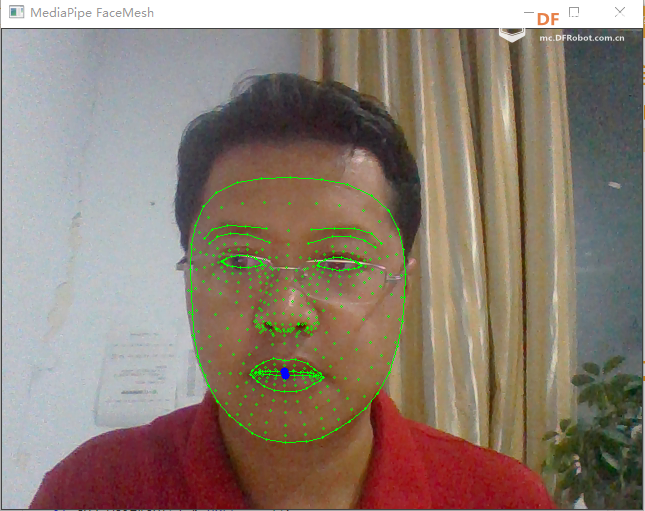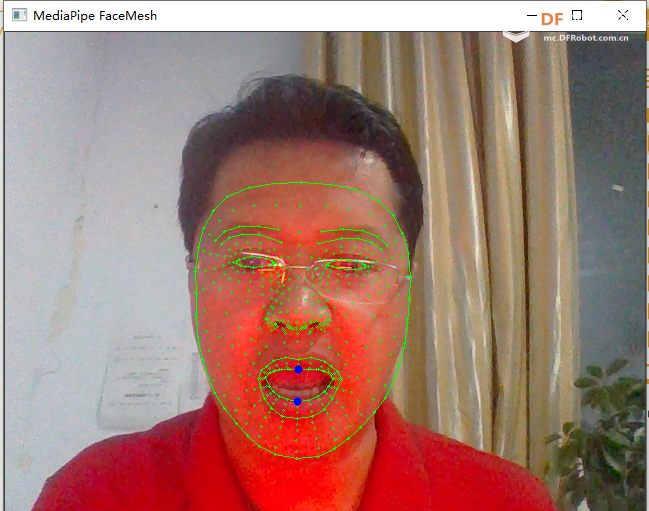本帖最后由 云天 于 2021-6-25 07:23 编辑 mediapipe.dev/ Arduino 板上RGB灯带。【MediaPipe 面网格】【Mind+MediaPipe 面网格】 mediapipe “【标识468个面部标志】
import cv2
import time
import mediapipe as mp
mp_drawing = mp.solutions.drawing_utils
mp_face_mesh = mp.solutions.face_mesh
from pinpong.board import Board,Pin,NeoPixel
NEOPIXEL_PIN = Pin.D7
PIXELS_NUM = 7 #灯数
Board("uno").begin() #初始化,选择板型和端口号,不输入端口号则进行自动识别
np = NeoPixel(Pin(NEOPIXEL_PIN), PIXELS_NUM)
# For webcam input:
drawing_spec = mp_drawing.DrawingSpec(thickness=1, circle_radius=1)
cap = cv2.VideoCapture(0)
Width=cap.get(3)
Height=cap.get(4)
i=1
with mp_face_mesh.FaceMesh(
min_detection_confidence=0.5,
min_tracking_confidence=0.5) as face_mesh:
while cap.isOpened():
success, image = cap.read()
if not success:
print("Ignoring empty camera frame.")
# If loading a video, use 'break' instead of 'continue'.
continue
# Flip the image horizontally for a later selfie-view display, and convert
# the BGR image to RGB.
image = cv2.cvtColor(cv2.flip(image, 1), cv2.COLOR_BGR2RGB)
# To improve performance, optionally mark the image as not writeable to
# pass by reference.
image.flags.writeable = False
results = face_mesh.process(image)
# Draw the face mesh annotations on the image.
image.flags.writeable = True
image = cv2.cvtColor(image, cv2.COLOR_RGB2BGR)
if results.multi_face_landmarks:
for face_landmarks in results.multi_face_landmarks:
mp_drawing.draw_landmarks(
image=image,
landmark_list=face_landmarks,
connections=mp_face_mesh.FACE_CONNECTIONS,
landmark_drawing_spec=drawing_spec,
connection_drawing_spec=drawing_spec)
up=results.multi_face_landmarks[0].landmark[13]
down=results.multi_face_landmarks[0].landmark[14]
cv2.circle(image,(int(up.x*Width),int(up.y*Height)),4,(255,0,0),-1)
cv2.circle(image,(int(down.x*Width),int(down.y*Height)),4,(255,0,0),-1)
for i in range(0,468):#标记468个3D 面部标志。
text=results.multi_face_landmarks[0].landmark[i]
cv2.putText(image, str(i), (int(text.x*Width),int(text.y*Height)),cv2.FONT_HERSHEY_SIMPLEX, 0.3, (255, 0, 0), 1)
print(abs(down.y-up.y)*Height)
if(abs(down.y-up.y)*Height)>20:
for num in range(0,7):
np[num]=(255,0,0)
else:
for num in range(0,7):
np[num]=(0,0,0)
cv2.imshow('MediaPipe FaceMesh', image)
if cv2.waitKey(5) & 0xFF == 27:
break
cap.release()
复制代码 【张嘴请开灯】
【睁眼请开灯】 up=results.multi_face_landmarks[0 ].landmark[159 ]0 ].landmark[145 ]
import cv2
import time
import mediapipe as mp
mp_drawing = mp.solutions.drawing_utils
mp_face_mesh = mp.solutions.face_mesh
from pinpong.board import Board,Pin,NeoPixel
NEOPIXEL_PIN = Pin.D7
PIXELS_NUM = 7 #灯数
Board("uno").begin() #初始化,选择板型和端口号,不输入端口号则进行自动识别
np = NeoPixel(Pin(NEOPIXEL_PIN), PIXELS_NUM)
# For webcam input:
drawing_spec = mp_drawing.DrawingSpec(thickness=1, circle_radius=1)
cap = cv2.VideoCapture(0)
Width=cap.get(3)
Height=cap.get(4)
i=1
with mp_face_mesh.FaceMesh(
min_detection_confidence=0.5,
min_tracking_confidence=0.5) as face_mesh:
while cap.isOpened():
success, image = cap.read()
if not success:
print("Ignoring empty camera frame.")
# If loading a video, use 'break' instead of 'continue'.
continue
# Flip the image horizontally for a later selfie-view display, and convert
# the BGR image to RGB.
image = cv2.cvtColor(cv2.flip(image, 1), cv2.COLOR_BGR2RGB)
# To improve performance, optionally mark the image as not writeable to
# pass by reference.
image.flags.writeable = False
results = face_mesh.process(image)
# Draw the face mesh annotations on the image.
image.flags.writeable = True
image = cv2.cvtColor(image, cv2.COLOR_RGB2BGR)
if results.multi_face_landmarks:
for face_landmarks in results.multi_face_landmarks:
mp_drawing.draw_landmarks(
image=image,
landmark_list=face_landmarks,
connections=mp_face_mesh.FACE_CONNECTIONS,
landmark_drawing_spec=drawing_spec,
connection_drawing_spec=drawing_spec)
up=results.multi_face_landmarks[0].landmark[159]
down=results.multi_face_landmarks[0].landmark[145]
cv2.circle(image,(int(up.x*Width),int(up.y*Height)),4,(255,0,0),-1)
cv2.circle(image,(int(down.x*Width),int(down.y*Height)),4,(255,0,0),-1)
#for i in range(0,468):#标记468个3D 面部标志。
#text=results.multi_face_landmarks[0].landmark[i]
#cv2.putText(image, str(i), (int(text.x*Width),int(text.y*Height)),cv2.FONT_HERSHEY_SIMPLEX, 0.3, (255, 0, 0), 1)
print(abs(down.y-up.y)*Height)
if(abs(down.y-up.y)*Height)>8:
for num in range(0,7):
np[num]=(255,0,0)
else:
for num in range(0,7):
np[num]=(0,0,0)
cv2.imshow('MediaPipe FaceMesh', image)
if cv2.waitKey(5) & 0xFF == 27:
break
cap.release()
复制代码 【演示视频】






 沪公网安备31011502402448
沪公网安备31011502402448